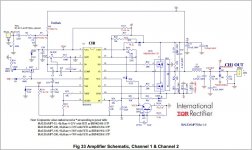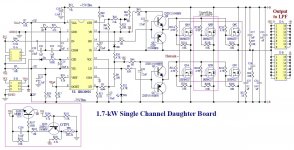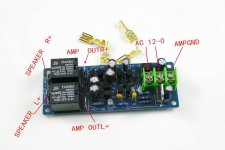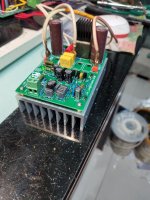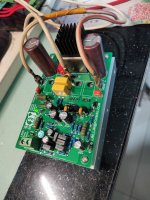Irs2092 works at a voltage of about 14V DC.The issue is the heating of the 2092, that has no heatsink and blows up. The switchers themselves dont run very hot...
Whether the voltage of your main power supply is + - 70V or l15d + - 50V.
The irs2092s operates at 15V. It has a separate regulated power supply.
It will not be affected by the voltage of your power supply.
So it won't get hot.
The severe fever is irfb4227. And inductors. if possible. You can point a fan at them.
But it doesn't matter if there is no fan.
All these circuits are OK. But it won't make much difference.May I ask is this circuit working properly???
I need to install 1 set
This is like a class AB amplifier. The same circuit. You use a pair of transistors. And use 3 pairs of transistors. In fact, there is no difference. 3 pairs of transistors will generate more heat.
Not sure I understand this. The IRS2092 can handle voltage swings of +/- 100vdc, which suggests an inbuilt VAS stage to drive the output mosfets... given the chip is handing 120-200 vPP, I can definitely see it heating up as other have suggested. I myself had 2 L30D boards blow up on +/- 75 v supplies with NO signal input after 15-20 minutes of running fine.... 2 boards not one. This suggests an inherent inadequacy...Irs2092 works at a voltage of about 14V DC.
Whether the voltage of your main power supply is + - 70V or l15d + - 50V.
The irs2092s operates at 15V. It has a separate regulated power supply.
It will not be affected by the voltage of your power supply.
So it won't get hot.
The severe fever is irfb4227. And inductors. if possible. You can point a fan at them.
But it doesn't matter if there is no fan.
I have several amps based on this design (L15d pro) that are very stable, produce little or no heat and generate very high quality sound. All of them use a seperate 15v regulated power supply (Q105, Z102) for the Irs2092 (as based on the original IR example design). The HT supply is +-70v SMPS. All amps are in closed boxes with no additional fans or heat sinks. They have been in service for years, without failure and are used for long duration on a daily basis.Not sure I understand this. The IRS2092 can handle voltage swings of +/- 100vdc, which suggests an inbuilt VAS stage to drive the output mosfets... given the chip is handing 120-200 vPP, I can definitely see it heating up as other have suggested. I myself had 2 L30D boards blow up on +/- 75 v supplies with NO signal input after 15-20 minutes of running fine.... 2 boards not one. This suggests an inherent inadequacy...
Attachments
No heatsinking on the IRS chip? If so that suggests a max of 70v supplies without heatsinking... ?I have several amps based on this design (L15d pro) that are very stable, produce little or no heat and generate very high quality sound. All of them use a seperate 15v regulated power supply (Q105, Z102) for the Irs2092 (as based on the original IR example design). The HT supply is +-70v SMPS. All amps are in closed boxes with no additional fans or heat sinks. They have been in service for years, without failure and are used for long duration on a daily basis.
Why?? As LJM has indicated, HT supply or even power output have no effect on the IRS2092. It runs from a seperate 15v power supply. In the circuit above taken from the HT supply, in other designs from a seperate regulated rail. The IRS2092 has suffiecient power to drive the MOSFETS directly without heating. In more powerfull module the Parallel MOSFETS are driven by a transistor driver stage, but like the direct MOSEFETS in the previous circuit, the requirment is not enough to heat the IRS2092 device, even with the HT into 100s of volts and KWs of drive, only the output MOSFETS, or inductors can ever suffer heating.No heatsinking on the IRS chip? If so that suggests a max of 70v supplies without heatsinking... ?
In the my case and my L15D Pro, the module is in an enclosed ABS box, with the IRS2092 in direct contact with the plastic. The IRS2092 is surface mounted on the back of the board, never even gets warm and the MOSFETS (and TIP31c power reg.) only slightly with the stock heatsink provided. Today the tempreture reached 40º degrees in the studio, these have been on all day and the enclosure is cooler than the wall.
Attachments
It is regrettable. But L30D is used by many people.Not sure I understand this. The IRS2092 can handle voltage swings of +/- 100vdc, which suggests an inbuilt VAS stage to drive the output mosfets... given the chip is handing 120-200 vPP, I can definitely see it heating up as other have suggested. I myself had 2 L30D boards blow up on +/- 75 v supplies with NO signal input after 15-20 minutes of running fine.... 2 boards not one. This suggests an inherent inadequacy...
Especially Chinese customers. If they are damaged, they will definitely trouble me. Because they can find me anytime.
But for many years. They didn't look for me.
I suggest you use a transformer. Instead of switching power supply. Because I have repaired the switching power supply. About 200 switching power supplies are maintained every day. This power supply is easily damaged.
I have never seen a damaged box of transformer in more than 20 years.
In addition, if you can send L30D to me for research. I'll find out the cause of the damage. And give you two no problem. But this L30D is very simple. It is actually iraudamp9. No special treatment.
In fact, its temperature is lower than iraudamp9
Iraudamp9 is about 110 ° C.
L30D 63 ° C
Friend, I don't think you have really used l15d L30DNo heatsinking on the IRS chip? If so that suggests a max of 70v supplies without heatsinking... ?
Or iraudamp9.
This is a very simple question. Irs2092 will not heat up.
Infineon has never added a radiator to the irs2092.
It is a driver chip. It is suspended with MOSFET.
This should be easy to understand.
Whats the lowest/ Max rails you recommend? I have one board left, will give it another chanceFriend, I don't think you have really used l15d L30D
Or iraudamp9.
This is a very simple question. Irs2092 will not heat up.
Infineon has never added a radiator to the irs2092.
It is a driver chip. It is suspended with MOSFET.
This should be easy to understand.
I have been using it myself.Whats the lowest/ Max rails you recommend? I have one board left, will give it another chance
Transformer AC 45-0-45. Use a set of capacitors with a total of 80V 22000 UF.
It's simple.
If you are damaged. You can contact your seller. Let him mail you transistors for free. Or damaged accessories. I can give it to you.
This is my opinion. I suggest you use a lower voltage.The older discussions talk about this being able to handle 75-80 vdc, thats about 55-0-55vac... with 45-9-45 It will only make about 175w/8e or 275w/4e
It can reduce the calorific value. It will be safer.
In fact, power is of little practical use.
I mostly recommend l15d SMD. It adopts + - 50V dc
There is little calorific value.
L30D can indeed use AC 50-0-50.
Fans are recommended.
In fact, we use L30D without failure.
So. You must be advised to use a safer way. If you think what I said is meaningless. Then I can't help it.
In addition, I would like to add.The older discussions talk about this being able to handle 75-80 vdc, thats about 55-0-55vac... with 45-9-45 It will only make about 175w/8e or 275w/4e
In fact, I found that Infineon MOSFET has many problems.
For example, irfb4020 and irfb4227. Different places of origin. It works on the same circuit with a temperature difference of three times. I think Infineon's quality management system has serious problems. If you can. You can buy several pieces of irfb4227 made in Mexico. It hardly heats up. The fever of irfb4227 produced in China and the Philippines is very serious. They are all authentic products of Infineon.
As far as I know. Irfb4227 produced by Maxco is very good. It hardly heats up.Can I use other parts apart from 4227's? I dont mind stepping up to higher powered parts available in digikey...
However, irfb4227 produced in the Philippines is very hot.
The factory of Infineon is to blame. Maxco products are hard to buy.
I found I had to be careful using higher power mosfets as many have higher gate capacitance which requires stronger drive signal.Can I use other parts apart from 4227's? I dont mind stepping up to higher powered parts available in digikey...
This caused amp to cut out at high power levels due to mosfet not switching on fast enough and amp thinking there was overload.
I used TC4420 gate drivers to drive 2 pairs of 4227's.
You need a DC protection.I have been using this amplifier for few years after some mods suggested by Greg the amplifier is working very well.
Now my doubt is does it have DC protection? and short circuit protection? do I need to use one if it does not have.
It must be relay based. Triode protection is not safe.
Attachments
The new L30D uses a 220g radiator.The older discussions talk about this being able to handle 75-80 vdc, thats about 55-0-55vac... with 45-9-45 It will only make about 175w/8e or 275w/4e
The temperature of IRFB4227 can be controlled below 40 ℃.
Attachments
- Home
- Amplifiers
- Class D
- L30D IRS2092 IRFB 4227 IRAUDAMP9 MYDIY
